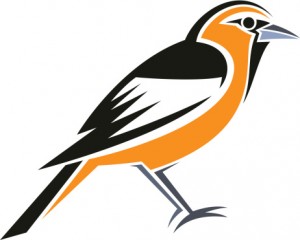 If you’ve ever seen the bright flash of a Baltimore Oriole as it flits its way around the forest edge, then you know there isn’t anything quite as lovely as the stark contrast of this brilliant orange bird against the deep green deciduous tree line. The song of the Baltimore Oriole is as lovely as his plumage; he projects a pure, flute-like whistle with a rich tone. His mate makes the same call, but softer, and sometimes this pair delights birdwatchers (and listeners) with a duet. You can enjoy the sights and sounds of the Baltimore Oriole all summer long in the Adirondacks, but before you head out on your bird-watching mission, here are a few facts on this favorite harbinger of spring and lovely summer resident, courtesy of the Cornell Lab of Ornithology.
If you’ve ever seen the bright flash of a Baltimore Oriole as it flits its way around the forest edge, then you know there isn’t anything quite as lovely as the stark contrast of this brilliant orange bird against the deep green deciduous tree line. The song of the Baltimore Oriole is as lovely as his plumage; he projects a pure, flute-like whistle with a rich tone. His mate makes the same call, but softer, and sometimes this pair delights birdwatchers (and listeners) with a duet. You can enjoy the sights and sounds of the Baltimore Oriole all summer long in the Adirondacks, but before you head out on your bird-watching mission, here are a few facts on this favorite harbinger of spring and lovely summer resident, courtesy of the Cornell Lab of Ornithology.
If there ever was a regal bird, it might just have to be the Baltimore Oriole, which derives its name from the crest of Lord Baltimore because the colors of the bird and the crest are similar. The male bird is a brilliant orange and black, with a fully black head and one white bar on their otherwise black wings. Females and young males are nearly identical in looks, with more of a yellow-orange breast, and grey instead of black. Interestingly, unlike other birds, the female becomes brighter each time she molts, and eventually females can become almost as brilliant in color as their male counterparts. Baltimore Orioles prefer to nest high in leafy trees, right along the forest’s edge, riverbanks, or in smaller groves of trees. They don’t mind people, and will feed and nest in public parks, fruit orchards, or even your own backyard!
Baltimore Orioles build one of the more interesting nests in the bird world as well. Their nests are like socks, and they build them to hang from the tree branch and are woven together with slender materials like grasses, strips of bark, wool, and hair, as well as foraged man-made materials like string, thin plastics, fishing line and twine. Female Baltimore Orioles are the weavers and they are resourceful, often using materials from an old nest to construct a new one. Males sometimes assist in procuring the materials needed, but they don’t participate in the actual weaving of the nest. Elms, maples and cottonwoods are the trees of choice for nest building. Here, the female will lay a clutch of three to six pale blue eggs with dark markings; the male Baltimore Oriole will defend the area surrounding the nest.
Baltimore Orioles primarily eat insects, fruit and nectar. In the summer months, they opt for a diet high in protein, and that means eating more bugs. This eating pattern is due to breeding and feeding their young, but it also serves another important purpose – many of the insects consumed by the Baltimore Oriole are pests, like tent caterpillars, fall webworms and spiny elm caterpillars. Baltimore Orioles love fruits and berries – especially darker fruits like mulberries, cherries and deep purple grapes. This can lead to the bird sometimes becoming a pest itself – they’ve been known to devastate fruit crops. If you want to draw Baltimore Orioles to your feeder, ripe fruit should be your lure of choice – cut oranges in half and hang them from trees, or put out very small amounts of jelly. Plant fruits that attract Baltimore Orioles such as raspberries, blackberries and crab apples.
Don’t expect to see your Baltimore Oriole friends in the winter months, though – they begin to migrate to warmer climes from late July through early September. Their winter vacationlands include Florida, the Caribbean, Central America, and the northernmost part of South America. It won’t be until April that they begin their way back to our forests, orchards and backyards; by May, most have returned and started to build their nests once again. While conservationists are not overly concerned about the population of Baltimore Orioles – they number more than 10 million – because of their migratory patterns they are more vulnerable to loss of their habitats on a multi-national level. It’s important for conservationists from both North and South America to work cooperatively to ensure that the brilliant orange, cheerful bird can be enjoyed for generations to come.
If you’d like to learn more about the Baltimore Oriole, as well as numerous other birds, visit the Cornell Lab of Ornithology online at www.allaboutbirds.org. If you’d like to create a bird feeder that brings the birds from the woods into your backyard, the place to start is Charlie Johns, where you’ll find a wide variety of wild bird food to feed your hungriest feathered friends.